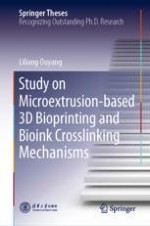2019 | OriginalPaper | Buchkapitel
5. 3D Bioprinting of Thermal-Sensitive Bioink
verfasst von : Dr. Liliang Ouyang
Erschienen in: Study on Microextrusion-based 3D Bioprinting and Bioink Crosslinking Mechanisms
Verlag: Springer Singapore
Aktivieren Sie unsere intelligente Suche, um passende Fachinhalte oder Patente zu finden.
Wählen Sie Textabschnitte aus um mit Künstlicher Intelligenz passenden Patente zu finden. powered by
Markieren Sie Textabschnitte, um KI-gestützt weitere passende Inhalte zu finden. powered by
